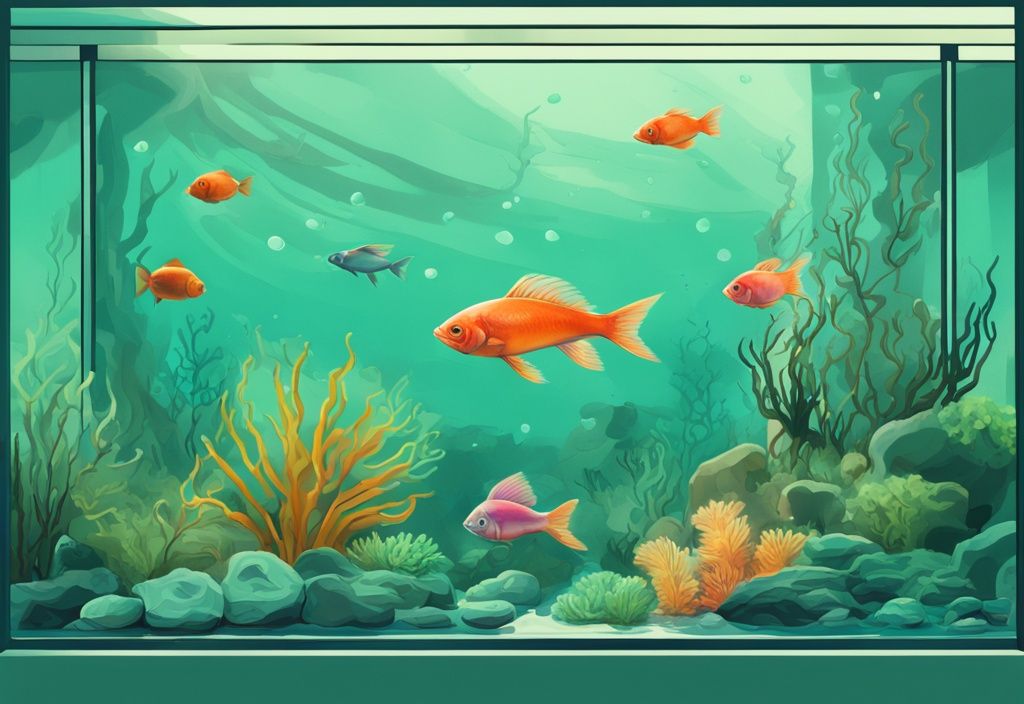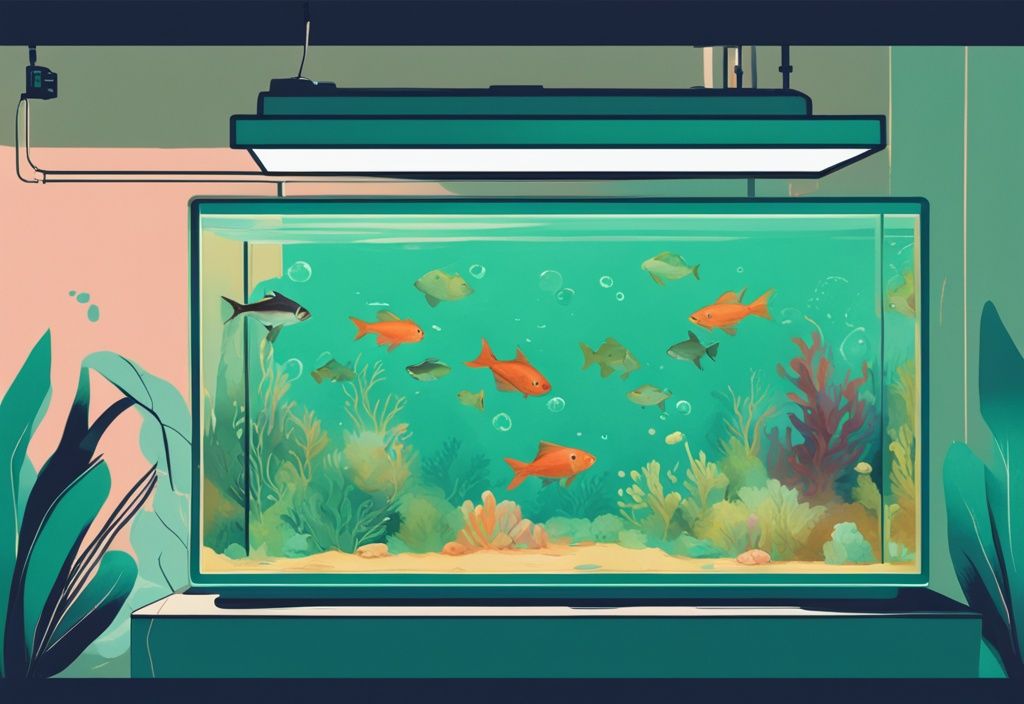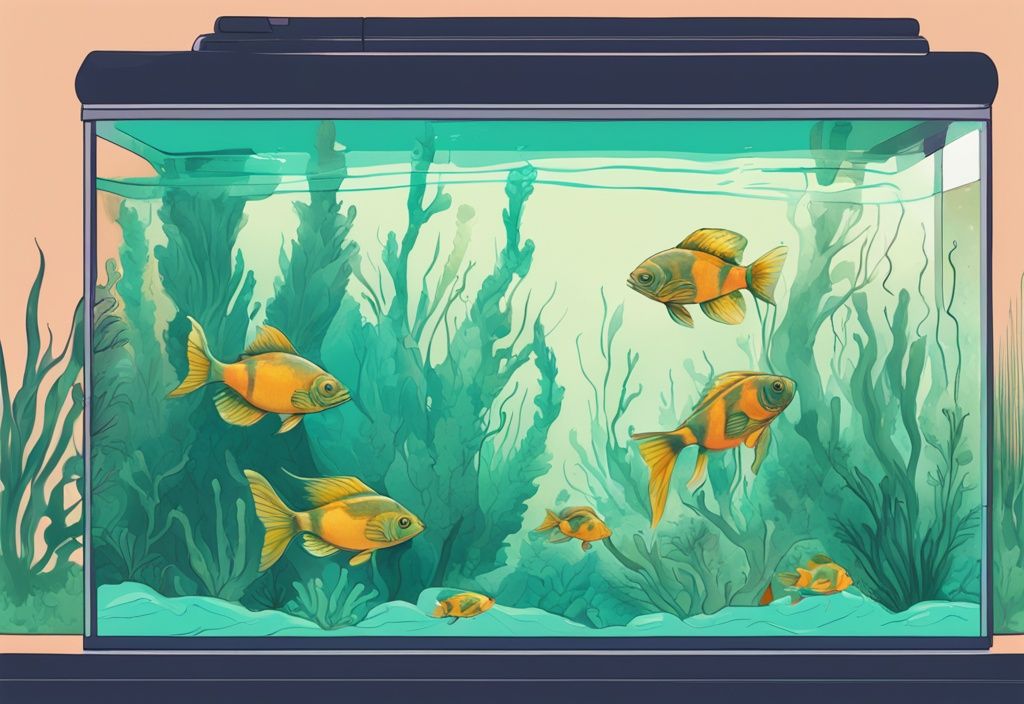“Oh those emerald waters!” It might sound majestic, but when it comes to your fish tank, this vivid green isn’t a pretty sight. It’s a common hurdle for aquarists: the unwelcome transformation of a crystal-clear tank into what appears to be pea soup.
But don’t despair – I’ve been in your shoes and am here to help you understand the “why” behind your green tank. We’ll unravel the science behind this phenomenon, dive into the effects on your picturesque underwater world, and provide effective solutions to restore its pristine clarity.
As a seasoned marine biologist, rest assured, this isn’t solely about aesthetics. We’re striving for a harmonious, healthy ecosystem for your aquatic pals. So, into the green we go — to bring back your tank’s original splendor!
What Makes Your Fish Tank Turn Green?
The Effects of Phytoplankton
If you’ve ever pondered, why is my fish tank green, the root cause often lies in a remarkable microorganism known as phytoplankton. These suspended algae love conditions like abundant light and excess nutrients, and when such conditions are met, they multiply rapidly. Imagine a bustling city growing overnight; that’s how quickly your tank water can shift from crystal clear to murky green. Although phytoplankton isn’t a direct threat to your fish, it does create a major hurdle for aquatic plants by hogging all the essential light they need. The result is a visually displeasing tank with an unbalanced ecosystem where your lovely plants struggle to thrive.
The Impact of Excessive Light Exposure
One of the primary catalysts for algae growth is excessive light, leading many to endlessly question, why is my fish tank green. Both direct sunlight and overly strong artificial lights act like a spotlight on a stage, inviting a rapid bloom of phytoplankton. It’s akin to giving dessert to a child just before bedtime—fun at first but problematic after. When tank lights remain on for extended periods, they exacerbate this issue, creating a relentless cycle of green water. To break this cycle, managing your tank’s light exposure is crucial. For more insights on how to balance aquarium lighting to grow healthy plants and avoid algae, check out this informative article on balancing aquarium lighting. This not only helps prevent algal overgrowth but also fosters a balanced aquatic environment, where both fish and plants can coexist harmoniously.
Underlying Reasons For a Green Fish Tank
A green fish tank can often be an alarming sight, leaving many aquarists puzzled and concerned. However, understanding the root causes can not only quell worries but also guide you to effective solutions.
Nutrient Imbalances and Your Fish Tank’s Health
One of the primary reasons why your fish tank turns green is due to nutrient imbalances. High levels of nitrates and phosphates, commonly found in fish waste, overfeeding, and decomposing food, serve as food for algae, fostering their growth. Think of it as a buffet for algae, inviting them to take over your tank. Additionally, tap water used in tank filling or topping off may contain elevated levels of nitrates and phosphates, further exacerbating this issue.
If you’re curious how to get rid of bubbles on top of fish tank, managing chemical imbalances is crucial. Ammonia, a byproduct of fish waste and uneaten food, can also spike if not appropriately managed. This compound provides an additional nutrient source for algae. As ammonia levels rise, they create conditions even more favorable for green water algae, making the water look murky and unsightly, turning your once-clear tank into a green haze.
Poor Maintenance: A Green Fishtank Nightmare
Poor maintenance routines significantly contribute to algae problems in fish tanks. Skipping regular water changes can lead to nutrient buildup, which creates an ideal environment for algae to thrive. It’s similar to neglecting house chores; the mess only gets worse over time.
Not cleaning the gravel regularly allows uneaten food and waste to accumulate, breaking down into nitrates and phosphates that nourish algae growth. The gravel functions like the base of your ecosystem, and neglecting it can disrupt the entire balance.
An inadequate filtration system is another reason why your fish tank may turn green. Filters are designed to remove waste and excess nutrients, but if they are not cleaned or functioning efficiently, waste products can build up, unbalancing the tank’s ecosystem. It’s akin to using a vacuum cleaner with a full bag; it just doesn’t work.
Overcrowding your tank with too many fish can produce more waste than your filtration system can handle. Picture a bustling household; the more residents, the more upkeep required. Similarly, more fish lead to increased nutrient levels that promote green water.
The Harm of Green Water to Your Fish
The Real Effect of Green Water On Fish Health
Wondering “why is my fish tank green” and concerned about its impact on your fish? While green water may not be toxic to fish, it creates conditions that can indirectly affect their well-being. One major issue is deoxygenation, particularly during the night. Phytoplankton, the tiny algae responsible for green water, undergoes respiration in darkness, consuming oxygen that fish need to thrive. Consequently, you might notice your fish displaying stress behaviors like gasping at the water surface due to insufficient oxygen levels.

Additionally, the green tint reduces visibility within the tank, making it harder to monitor your fish’s health. Recognizing early signs of disease or distress becomes challenging, which could lead to delayed interventions and compromised fish health.
How Green Water Damages the Tank Ecosystem
Are you questioning “why is my fish tank green” and how it impacts the overall ecosystem? Persistent green water disrupts the delicate balance within your aquarium in several ways.
Firstly, the greenish hue blocks light, which is essential for the photosynthesis process of aquatic plants. Without adequate light, these plants struggle to grow, and eventually, their health deteriorates. This imbalance doesn’t just affect plant life but cascades through the entire tank ecosystem.
Healthy aquatic plants play a crucial role in controlling nutrient levels, providing oxygen, and offering shelter for fish. When green water hinders plant growth, the nutrient dynamics shift, often favoring more algae proliferation. This further disturbs the ecosystem, making it challenging to maintain optimal conditions for both plants and fish.
Moreover, maintaining the ecosystem becomes labor-intensive, as regular cleaning and frequent water changes are necessary to manage the imbalances caused by green water. This not only stresses the aquatic life but also adds to the aquarist’s workload, making the entire fish-keeping experience more cumbersome than enjoyable.
Concrete Steps to Prevent Green Water
Maintaining a clear and healthy fish tank requires tackling algae growth effectively. From managing light exposure to carefully monitoring nutrient levels, a few strategic steps can keep that unwanted green tint at bay.
Managing Light in Your Aquarium
Why is my fish tank green? One primary reason is the overexposure of your aquarium to light, which significantly promotes algae growth. To tackle this, first, make sure your fish tank is placed away from direct sunlight. Sunlight not only heats the water but also encourages algae blooms. Instead, rely on artificial lighting, controlling its intensity based on the needs of your aquarium’s inhabitants.
To further refine light management, use a timer to automate the lighting schedule. Keeping the lights on for roughly 8-12 hours per day strikes a balance between providing sufficient illumination for your fish and plants and discouraging algae overgrowth. Additionally, if your tank location receives incidental sunlight, consider using light-blocking covers to mitigate exposure.
Keeping A Check On Nutrient Levels
Nutrient imbalances are a significant factor in answering the question, “Why is my fish tank green?” Overfeeding fish inevitably leads to excess food settling in the tank, which breaks down into nitrates and phosphates that feed algae. To combat this, always feed your fish appropriately, mindful of the quantity they can consume within a few minutes. This reduces the nutrient load in the water.
Regularly replacing a portion of the water in your tank is another fundamental step. This practice helps in controlling nitrate and phosphate levels, preventing them from reaching concentrations that favor algae growth. A high-quality filtration system further supports a balanced nutrient environment. Filters mechanically remove solid waste and biologically transform harmful chemicals into less detrimental substances, maintaining overall water quality.
Why Maintenance and Cleaning Matters
Proper maintenance is essential to preventing the pesky green tint in your aquarium. Consistently performing partial water changes is crucial, as it removes excess nutrients that contribute to algae proliferation. For best results, establish a regular water change schedule suited to your tank size and fish population.
Additionally, cleaning the tank’s gravel, walls, and decorations should not be overlooked. Uneaten food and detritus settle at the bottom, breaking down into nutrients that algae thrive on. Use a gravel vacuum during water changes to extract debris effectively. Equally important is ensuring that the tank’s filtration system is clean and functioning efficiently. Filters can become clogged with waste, diminishing their effectiveness, so regular cleaning is necessary to maintain optimal performance.
The Importance of Regular Water Testing
To keep your aquarium water clear and healthy, regular testing of water parameters is essential. This practice allows you to monitor levels of nitrates, phosphates, ammonia, and pH, all of which impact algae growth. By understanding these values, you can address the root causes of the question, “Why is my fish tank green?” and make informed adjustments to your tank’s maintenance routine.
Based on test results, tweak your feeding, lighting, and cleaning practices as needed. For instance, if nitrate levels are high, consider reducing feed amounts or increasing water change frequency. Regular testing helps detect imbalances before they escalate into full-blown algae blooms, keeping your tank’s ecosystem stable and visually appealing.
Effective Solutions to Clear Green Water
Are you puzzled by that green tinge in your tank? Let’s explore the key methods to tackle green water and get your aquarium sparkling again.

Role of Regular Water Changes
One of the most effective solutions when wondering why is my fish tank green lies in the regular practice of partial water changes. Regular water changes are crucial for maintaining a balanced aquarium environment. By replacing a portion of the tank water frequently, you can significantly decrease nutrient concentrations that contribute to algae growth.
When changing the water, it’s important to also vacuum the substrate to remove uneaten food and accumulated waste. This process not only keeps the tank cleaner but also helps in diluting the nutrient levels naturally.
The Power of UV Sterilizers: A Closer Look
For those dealing with persistent green water issues and asking why is my fish tank green, UV sterilizers offer a powerful solution. These devices work by passing water through ultraviolet light, which targets and kills suspended algae cells by altering their DNA.
Installing a UV sterilizer can act as a long-term fix by preventing algae reproduction. By integrating a UV sterilizer into your aquarium setup, you enhance the overall water clarity and keep algae at bay.
How Effective are Algae-Eating Fish or Invertebrates?
Natural methods of controlling algae growth can also be highly effective for those questioning why is my fish tank green. Introducing algae-eating fish such as Siamese algae eaters or specific invertebrates like certain snail species can help manage algae levels.
These inhabitants consume algae, complementing other preventive measures to control its growth. However, it is crucial to select species that are compatible with your existing aquarium inhabitants to maintain a harmonious environment.
Addressing the Issue: Preventing Future Green Tanks
Curious about what lays the foundation of pristine, clear water? Let’s explore the essentials!
The Balance of Light and Nutrients
Maintaining the delicate balance of light and nutrients is crucial to prevent the question of “why is my fish tank green” from arising. Start by establishing a well-regulated lighting schedule. Aquarium lights should typically run for about 8-12 hours a day, using a timer to achieve consistency.
Reducing light intensity can also combat excessive algae growth, particularly if your tank receives natural sunlight. Implementing a controlled feeding regimen is vital. Overfeeding contributes significantly to nutrient overload, particularly nitrates and phosphates, which fuel algae blooms.
Additionally, consider the quality of your tap water. Often, tap water can be high in nutrients, so opt for purified or treated water to mitigate this issue. This careful balance acts like a seesaw in a playground; just the right amount keeps things fun and enjoyable.
Enhancing Maintenance Routines: The Basics
Developing a consistent cleaning and maintenance schedule is essential for a healthy tank ecosystem. Regular water changes, typically weekly or bi-weekly, help manage nutrient levels. Along with water changes, thorough substrate cleaning removes uneaten food and fish waste, reducing nutrient buildup.
Filter maintenance is also crucial; ensure filters are cleaned and functioning efficiently to keep the water clear. Promptly removing excess organic matter, such as dead plants and leftover food, prevents nutrient accumulation. Think of it like tidying up a room—less clutter creates a more peaceful environment.
Regularly inspect tank conditions and equipment for proper functioning to maintain a stable environment. By adhering to these maintenance routines, you will significantly reduce the chances of your tank turning green. Remember, a little effort goes a long way in keeping your aquatic friends happy.

Conclusion
Persistent green water in your fish tank is a clear indication that there’s an imbalance within the ecosystem. One of the common questions among aquarists is, “why is my fish tank green?” The answer lies in the excessive growth of algae, largely due to uncontrolled light exposure and nutrient imbalances.
Achieving a clear tank demands a multi-pronged strategy. Controlling light exposure is a crucial first step. Ensure your tank is placed away from direct sunlight, and regulate artificial lighting rigorously. Using a timer to manage light exposure, typically 8-12 hours a day, can effectively prevent excessive algae bloom.
Nutrient levels are another pivotal factor in maintaining a clear aquarium. Overfeeding your fish or significant waste build-up can lead to high nitrate and phosphate levels, which algae thrive on. Therefore, it’s essential to feed the right quantities and conduct regular water changes to keep these nutrients in check. High-quality filtration systems further help maintain this balance by removing excess waste and organic matter.
For those interested in large-scale aquarium setups, you might wonder about what the biggest aquarium in the world is. Moreover, consistent cleaning routines are indispensable. Regularly cleaning your tank’s gravel, walls, and filtration system prevents the accumulation of organic matter that fuels algae growth. A clean environment not only prevents green water but also promotes a healthier ecosystem for all tank inhabitants.
Finally, achieving and maintaining clear water involves preventive measures and effective solutions. Tools like UV sterilizers and algae-eating fish can offer long-term solutions to persistent green water issues. However, the foundation of a pristine tank lies in patience and consistency. By diligently applying these strategies, you can enjoy a vibrant, healthy aquarium free from the nuisance of green water.
Must-Know FAQ’s When Dealing With a Green Fish Tank
Discover essential tips and insights to address the common issues associated with a green fish tank, ensuring a healthy and balanced aquatic environment.
Why Does My Aquarium Turn Green Fast?
Ah, the age-old question! If your aquarium turns green swiftly, blame it on the rapid algae bloom. Several culprits could be at play here: excessive light exposure, nutrient imbalances, poor maintenance, and even overfeeding. High levels of nitrates and phosphates are like a buffet for green water algae, encouraging them to grow at an alarming rate.
Can Green Water Really Harm My Fish?
Now, while green water isn’t a villain directly harmful to your fish, it has its sneaky ways. Green water can deplete oxygen levels, particularly during the night, making it tough for your fish to breathe. Additionally, it obstructs the light your plants need, causing stress due to poor water quality and reduced oxygen levels.
How Frequently Should I Change Water to Keep it Clear?
Regular water changes are your best ally here. Perform partial water changes weekly or bi-weekly, based on the size of your tank and the number of inhabitants. This practice helps in managing nutrient levels and maintaining water clarity, thereby reducing the chances of green water.
Will Having More Plants Help Reduce Green Water?
Absolutely! Introducing more aquatic plants into your tank is a smart move. They compete with algae for nutrients, which significantly limits algae growth opportunities. However, keep a balanced plant population to ensure effective algae control.
What is the Ideal Light Duration to Prevent Algae Growth?
Lighting plays a crucial role in algae management. It’s best to keep your aquarium lights on for about 8-12 hours per day. Using a timer to maintain a consistent lighting schedule can prevent excessive light exposure, which often promotes algae growth.
Understanding the Role of UV Sterilizers in Green Water Control
UV Sterilizers can be a game-changer in your fight against green water. They efficiently kill suspended algae, helping to clear the water. However, they work best as part of a comprehensive algae control strategy that includes proper light and nutrient management.
